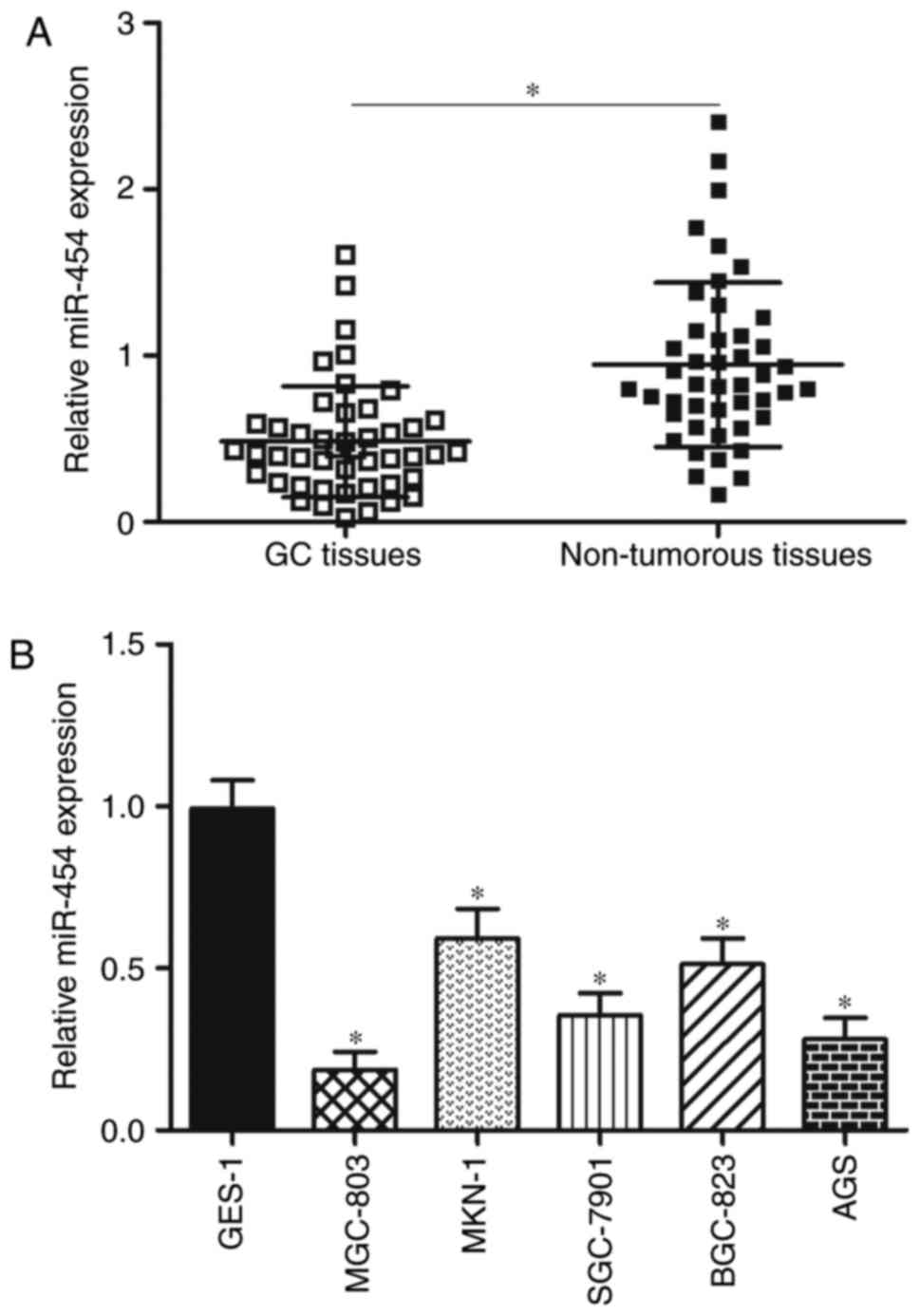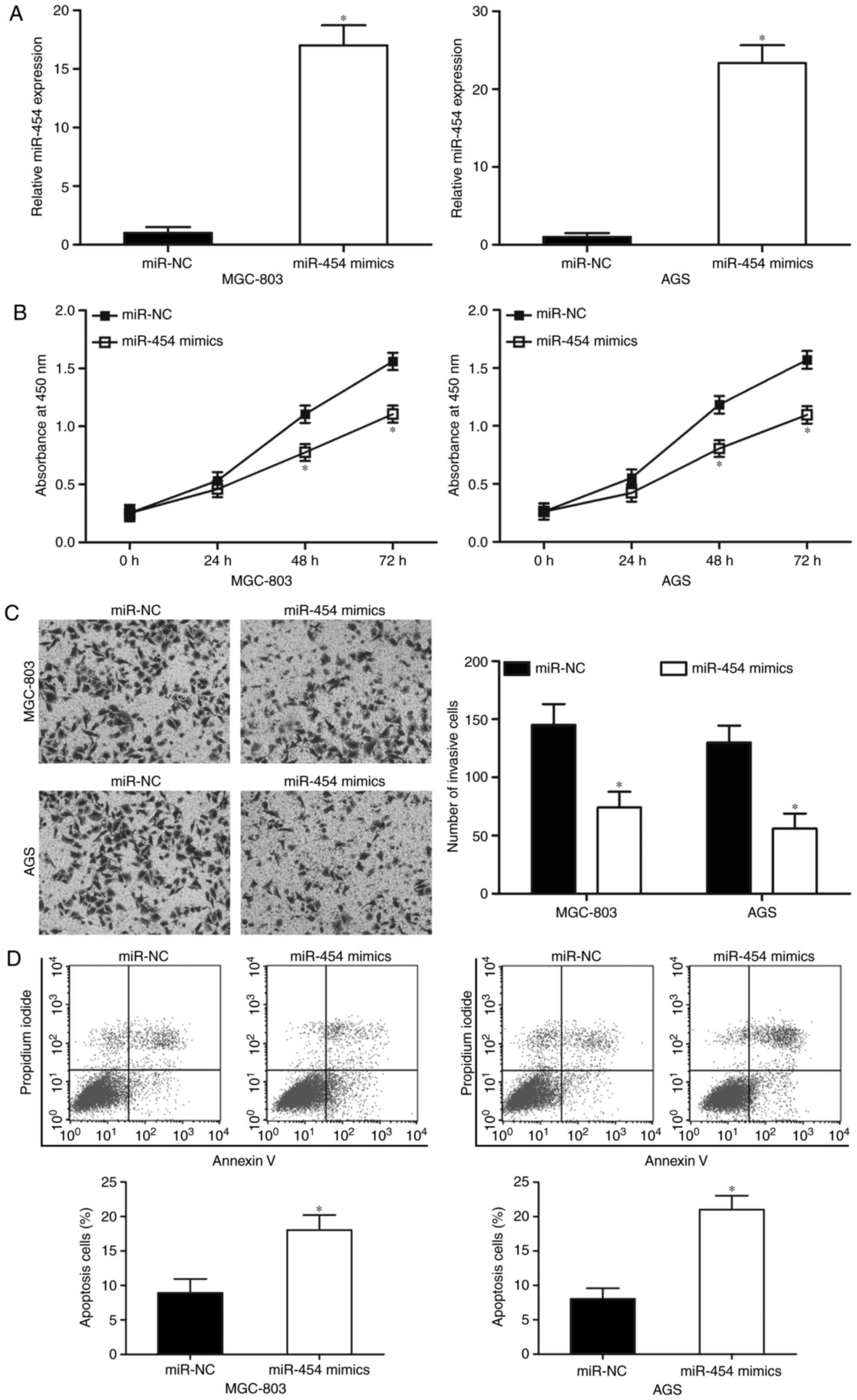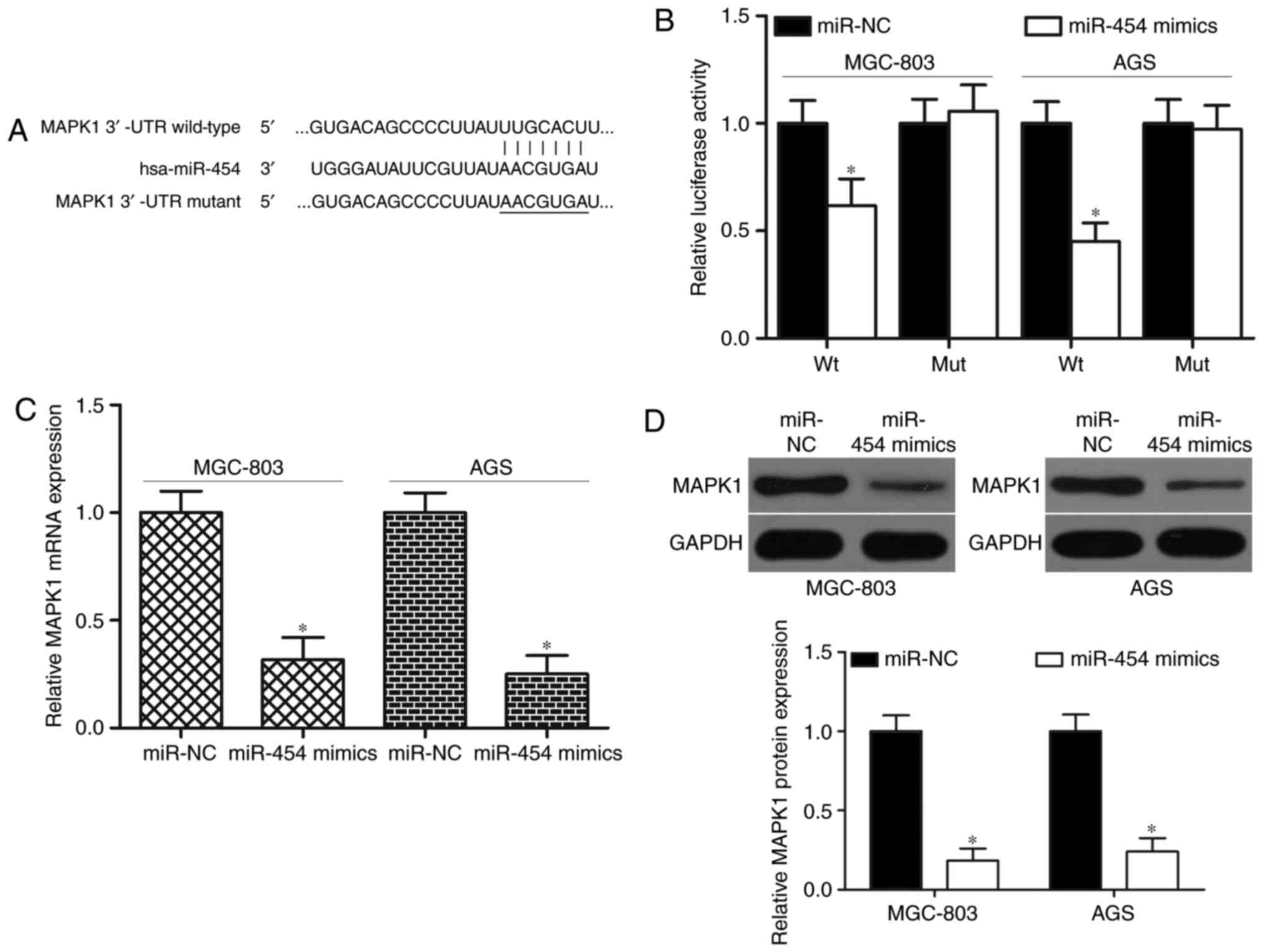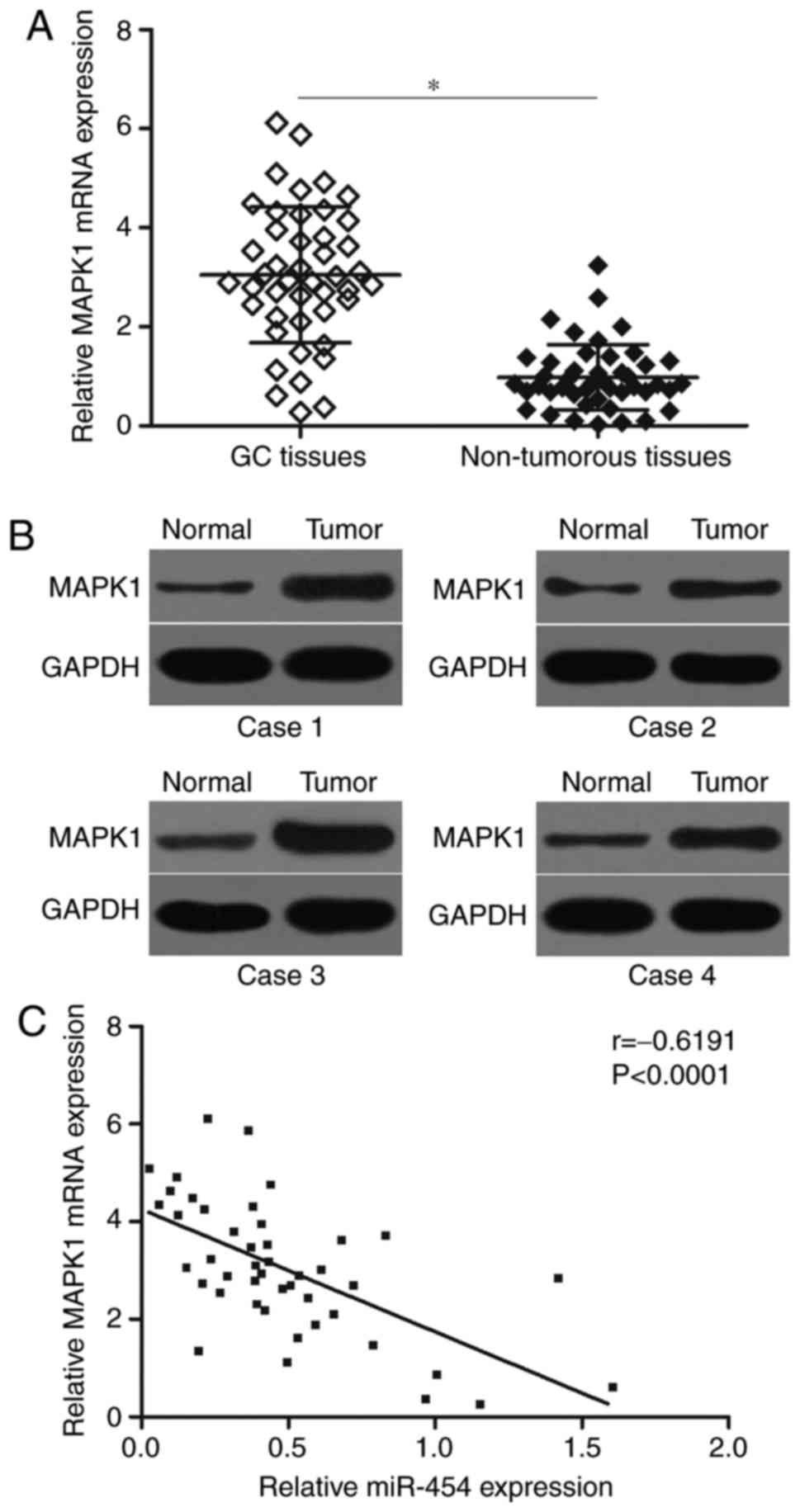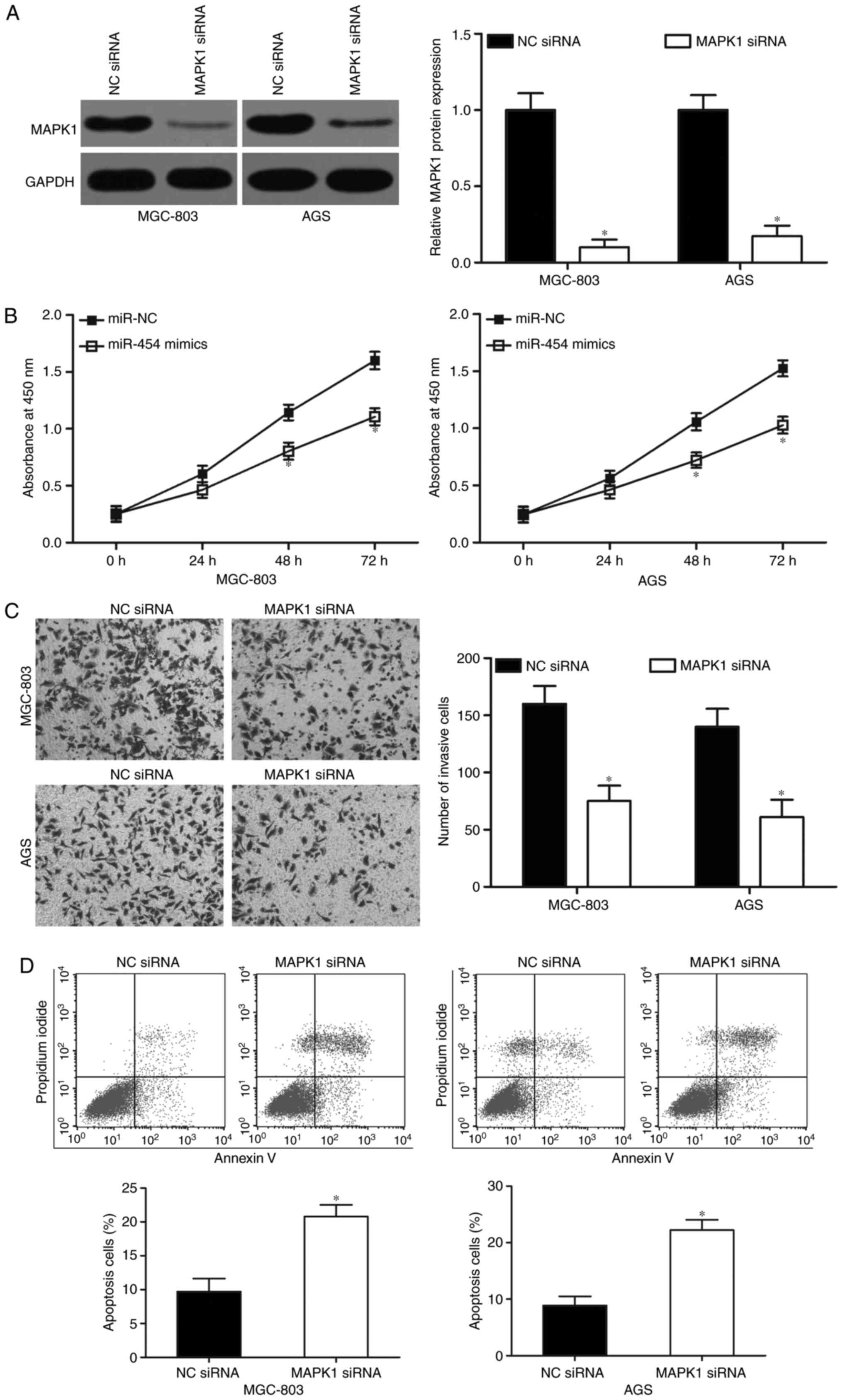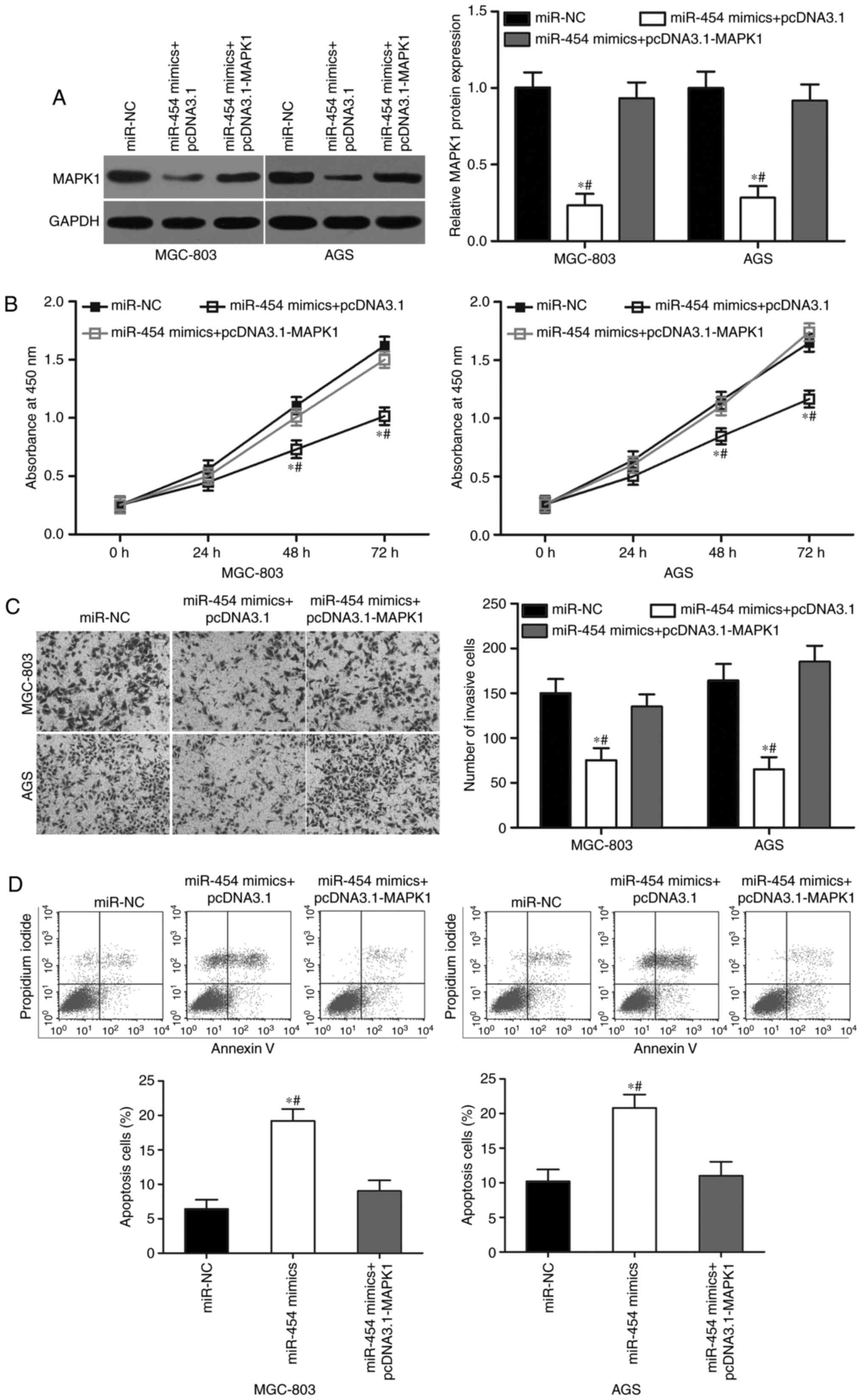MicroRNA-454 inhibits the malignant biological behaviours of gastric cancer cells by directly targeting mitogen-activated protein kinase 1
Retraction in: /10.3892/or.2022.8276
- Authors:
- Published online on: December 20, 2017 https://doi.org/10.3892/or.2017.6171
- Pages: 1494-1504
Abstract
Introduction
Gastric cancer (GC) is the fifth most commonly diagnosed malignant disease and the third leading cause of cancer-related deaths worldwide (1). In China, GC is the most common type of cancer, and an estimated 679,100 new cases and 498,000 deaths occur each year (2). Helicobacter pylori infection, Epstein-Barr virus infection, poor diet, tobacco use and obesity are some of the identified risk factors that contribute to GC initiation and progression (3–5). Currently, the predominant treatments for patients with GC are surgery, chemotherapy, radiotherapy, immunotherapy and targeted therapy (6). Despite tremendous advances in the treatment strategies for patients with GC in recent years, the prognosis for advanced GC patients remains poor, and the 5-year survival rate for GC patients remains at approximately 4–5% (7). The poor prognosis of GC patients is mainly attributed to invasion and metastasis, which are the major causes of GC-related recurrence and death (8,9). Therefore, the molecular mechanisms underlying GC development and progression must be elucidated to develop novel biomarkers for the diagnosis and effective treatments for patients with this disease.
MicroRNAs (miRNAs) are a novel group of endogenous, single-strand, noncoding and short RNA molecules that are 20–25 nucleotides in length (10). miRNAs exert negative genetic regulation by directly binding to the 3′-untranslated regions (3′-UTRs) of their target genes in a base-pairing manner and subsequently inducing translational silencing or degradation of mRNAs (11). Substantial evidence indicates that miRNAs play important roles in most biological processes in both normal development and in various diseases, including cancer (12,13). In recent years, miRNA dysregulation has been reported in various types of human cancers, such as GC (14), bladder cancer (15), colorectal cancer (16), glioma (17) and lung cancer (18). Furthermore, aberrantly expressed miRNAs are associated with tumourigenesis and tumour development and affect cell proliferation, cell cycle distribution, apoptosis, migration, invasion, angiogenesis and epithelial-mesenchymal transition (19–21). Cancer-associated miRNAs may function as oncogenes or tumour-suppressor genes depending on the roles of their target genes and tumour types (22). Thus, miRNAs can serve as diagnostic markers or therapeutic targets for anticancer therapy.
miR-454 is abnormally upregulated in multiple types of human cancer including uveal melanoma (23) and colorectal cancer (24), whereas it is weakly expressed in glioblastoma (25) and osteosarcoma (26). However, the expression pattern, biological roles and underlying mechanism of miR-454 in GC remain unclear and require further investigation. In the present study, we examined miR-454 expression in GC tissues and cell lines. We also explored the effects of miR-454 on the biological behaviours of tumour cells and the underlying molecular mechanisms of miR-454.
Materials and methods
Human tissue samples
This study was approved by the Ethics Committee of The Second Hospital of Jilin University. Written informed consent was obtained from each patient who participated in this research. A total of 45 paired GC tissues (adenocarcinoma) and matched adjacent non-tumourous tissues were obtained from patients who were treated with surgical resection at The Second Hospital of Jilin University between June 2014 and March 2016. The matched adjacent non-tumourous tissues were obtained 5 cm away from the tumour tissues. In addition, histological examination was also performed to confirm the non-tumourous tissues. No patient had undergone any pre-operative treatment, such as radiotherapy, chemotherapy, immunotherapy or targeted therapy. All these tissues were immediately frozen in liquid nitrogen and stored in a refrigerator at −80°C until further use. Clinical features of the GC patients were collected and are summarised in Table I.
Table I.Association between miR-454 expression and clinicopathological features of the gastric cancer patients (n=45). |
Cell lines, culture conditions and transfection
Human GC cell lines (MGC-803, MKN-1, SGC-7901, BGC-823 and AGS) and the normal gastric epithelium GES-1 cell line were acquired from the Shanghai Institute of Biochemistry and Cell Biology (Shanghai, China). All the cell lines were cultured in Dulbecco's modified Eagle's medium (DMEM) supplemented with 10% foetal bovine serum (FBS), 100 U/ml of penicillin and 100 mg/ml of streptomycin (Gibco; Thermo Fisher Scientific, Inc., Waltham, MA, USA) at 37°C with 5% CO2.
miR-454 mimics, miRNA mimic negative control (miR-NC), small interfering RNA targeting MAPK1 (MAPK1 siRNA) and its negative control (NC siRNA) were purchased from Guangzhou RiboBio Co., Ltd. (Guangzhou, China). MAPK1-overexpressing plasmid (pcDNA3.1-MAPK1) and blank plasmid (pcDNA3.1) were synthesised by the Chinese Academy of Sciences (Changchun, China). For transfection, the cells were seeded into 6-well plates at 60–70% confluence. Before transfection, the culture medium was replaced with antibiotic-free DMEM. Cell transfection was performed using Invitrogen Lipofectamine® 2000 (Thermo Fisher Scientific, Inc., Waltham, MA, USA) in accordance with the manufacturer's protocol.
RNA extraction and reverse transcription-quantitative polymerase chain reaction (RT-qPCR)
Total RNA was isolated from tissue samples or cells using TRIzol reagent (Invitrogen; Thermo Fisher Scientific, Inc.) according to the manufacturer's protocol. The total RNA concentration was examined using a NanoDrop ND-100 Spectrophotometer (NanoDrop Technologies, Wilmington, DE, USA). For the detection of miR-454 expression, total RNA was reverse-transcribed into cDNA using a TaqMan® MicroRNA Reverse Transcription kit (Applied Biosystems; Thermo Fisher Scientific, Inc.). Quantitative polymerase chain reaction (qPCR) was performed with TaqMan MicroRNA Assay kit (Applied Biosystems; Thermo Fisher Scientific, Inc.), and endogenous U6 snRNA was used as a control. For the quantification of MAPK1 expression, cDNA was synthesised using PrimeScript™ RT reagent kit (Takara Biotechnology Co., Ltd., Dalian China), followed by qPCR with SYBR Premix Ex Taq Master Mix (Takara Biotechnology Co., Ltd.). GAPDH was used as an internal control for MAPK1 mRNA expression. All experiments were performed in triplicate, and data were analysed with the 2−∆∆Cq method (27).
Cell Counting Kit-8 (CCK-8) assay
Transfected cells were collected at 24 h post-transfection and seeded into 96-well plates at a density of 3×103 cells per well. After culturing for 0, 24, 48 and 72 h, CCK-8 assay was performed according to the manufacturer's instructions. In brief, 10 µl of CCK-8 reagent (Beyotime, Shanghai, China) was added to each well. The cells were incubated at 37°C with 5% CO2 for 2 h. Absorbance was determined at a wavelength of 450 nm using an ELx808 absorbance reader (BioTek Instruments, Inc., Winooski, VT, USA). Each assay was performed in triplicate and repeated three times.
Transwell invasion assay
Transwell invasion assay was performed using Transwell plates (8 µm pores; Corning Inc., Corning, NY, USA) coated with Matrigel (BD Biosciences, Franklin Lakes, NJ, USA). Briefly, 5×104 transfected cells in FBS-free DMEM were added into the upper compartment of the chamber. The lower chamber was filled with DMEM containing 20% FBS to serve as a chemoattractant. After being incubated at 37°C with 5% CO2 for 24 h, the cells, which remained on the upper surface of the membrane, were carefully removed with cotton swabs. The invasive cells were fixed in methanol for 10 min, stained with 0.5% crystal violet solution for 10 min, washed in PBS and air-dried. Finally, images of five randomly selected fields of the invasive cells were obtained and counted under an inverted microscope (IX83; Olympus Corporation, Tokyo, Japan) at the magnification of ×200.
Flow cytometric assay
An Annexin V-fluorescein isothiocyanate (FITC)/propidium iodide (PI) staining kit (BD Biosciences) was utilised to determine the cell apoptotic rate. Cells were collected and washed in ice-cold PBS after 48 h of transfection. The cells were stained with 5 µl of Annexin V-FITC and 5 µl of PI for 15 min at room temperature in the dark after their resuspension in 1X binding buffer. Flow cytometry (Beckman Coulter, Inc., Brea, CA, USA) was then performed to determine the apoptosis rate. CellQuest® software (version 3.3; Becton Dickinson, Heidelberg, Germany) was used to analyse the data. The tests were performed in triplicate and repeated three times.
Target prediction
The potential targets of miR-454 were predicted using TargetScan (www.targetscan.org) and microRNA (www.microrna.org).
Luciferase reporter assay
Bioinformatic analysis predicted that MAPK1 is a candidate target of miR-454. Luciferase reporter assays were performed to determine whether MAPK1 is a direct target of miR-454. Luciferase reporter plasmids, psiCHECK2-MAPK1-3′-UTR wild-type (Wt) and psiCHECK2-MAPK1-3′-UTR mutant (Mut), were synthesised and confirmed by Shanghai GenePharma Co., Ltd. (Shanghai, China). The cells were seeded into 24-well plates at 50–60% confluence. After incubation overnight, the plasmid (psiCHECK2-MAPK1-3′-UTR Wt or psiCHECK2-MAPK1-3′-UTR Mut) together with miR-454 mimics or miR-NC were transfected into cells using Lipofectamine 2000 according to the manufacturer's protocol. After 48 h of incubation at 37°C with 5% CO2, the transfected cells were collected and analysed for luciferase activity using the Dual-Luciferase Reporter Assay System (Promega Corporation, Manheim, Germany). The firefly luciferase activity was normalised to Renilla luciferase activity.
Western blot analysis
Total protein was extracted from the tissue samples or cells using radioimmunoprecipitation assay lysis buffer (Beyotime Institute of Biotechnology, Haimen, China). Subsequent to the quantification of total protein concentration with a BCA assay kit (Beyotime Institute of Biotechnology), equal quantities of protein were separated by 10% SDS-PAGE and transferred to polyvinylidene fluoride membranes (EMD Millipore, Billerica, MA, USA). The membranes were blocked with 5% skimmed dry milk in TBST at room temperature for 2 h and incubated overnight at 4°C with primary antibodies: mouse anti-human monoclonal MAPK1 (sc-136288; 1:1,000 dilution; Santa Cruz Biotechnology, Inc., Santa Cruz, CA, USA) and mouse anti-human monoclonal GAPDH (sc-32233; 1:1,000 dilution; Santa Cruz Biotechnology, Inc.). The membranes were washed three times with TBST before they were incubated with goat anti-mouse horseradish-peroxidase-conjugated secondary antibody (sc-2005; 1:5,000 dilution; Santa Cruz Biotechnology, Inc.) at room temperature for 1 h. Protein bands were visualised using an enhanced chemiluminescence solution (Pierce, Rockford, IL, USA). Densitometry was quantified using Image J software version 1.41 (National Institutes of Health, Bethesda, MD, USA). GAPDH served as an internal control.
Statistical analysis
Data are presented as mean ± standard errors. All statistical analyses were performed with Student's t-tests or one-way analysis of variance plus multiple comparisons on SPSS 18.0 (SPSS, Inc., Chicago, IL, USA). Student-Newman-Keuls test was used as a post-hoc test following ANOVA. Spearman's correlation analysis was used to analyze the association between miR-454 and MAPK1 mRNA levels in GC tissues. The categorical data in this research were miR-454 group vs. miR-NC group; MAPK1 siRNA vs. NC siRNA group; miR-NC, miR-454 mimics+pcDNA3.1, miR-454 mimics+pcDNA3.1-MAPK1 groups. P<0.05 was considered to be statistically significant.
Results
miR-454 is downregulated in both GC tissues and cell lines
In order to evaluate the role of miR-454 in GC development, miR-454 expression was determined in 45 paired GC tissues and matched adjacent non-tumourous tissues by RT-qPCR. The results showed that the GC tissues had a significantly lower expression level of miR-454 compared with adjacent non-tumourous tissues (Fig. 1A; P<0.05). To clarify the clinical significance of miR-454 in GC, all patients were divided into an miR-454 low expression group (n=23) and miR-454 high expression group (n=22) on the basis of the median miR-454 expression. Table I shows that a low miR-454 expression level was positively associated with lymph node metastasis (P=0.026), invasive depth (P=0.001) and TNM stage (P=0.025). However, miR-454 expression was not significantly associated with age (P=0.626), sex (P=0.524), differentiation (P=0.463) and tumour size (P=0.873).
We detected miR-454 expression in five GC cell lines (MGC-803, MKN-1, SGC-7901, BGC-823 and AGS) and in normal gastric epithelium GES-1 cell line to validate whether aberrant downregulation of miR-454 also occurs in GC cell lines. RT-qPCR analysis data revealed that miR-454 was aberrantly downregulated in all GC cell lines compared with its expression in normal GES-1 cell line (Fig. 1B, P<0.05). These results suggest that miR-454 plays important roles in GC occurrence and development.
miR-454 inhibits GC cell proliferation and invasion and promotes apoptosis in vitro
MGC-803 and AGS cell lines, which expressed the lowest levels of miR-454 among the five GC cell lines tested, were selected for further experiments. Both cell lines were transfected with miR-454 mimics or miR-NC to investigate the biological functions of miR-454 in GC. We examined the expression levels of miR-454 in the MGC-803 and AGS cells by RT-qPCR 48 h after transfection to assess the efficiency of the miR-454 transfection. Fig. 2A shows that miR-454 was markedly upregulated in the MGC-803 and AGS cells after transfection with miR-454 mimics (Fig. 2A; P<0.05). CCK-8 assays were then performed on the MGC-803 and AGS cells, which were transfected with miR-454 mimics or miR-NC, to evaluate the effect of miR-454 in GC cell proliferation. The results indicated that the upregulation of miR-454 decreased the proliferation of MGC-803 and AGS cells when compared with the miR-NC group (Fig. 2B; P<0.05). Transwell invasion assays were performed to explore the effect of miR-454 on GC cell metastasis. Fig. 2C shows that restoration expression of miR-454 decreased the cell invasion abilities of the MGC-803 and AGS cells (P<0.05). Moreover, we studied whether miR-454 has any effect on GC cell apoptosis. The results of flow cytometry assay indicated that miR-454 overexpression promoted MGC-803 and AGS cell apoptosis (Fig. 2D; P<0.05). These results suggested that miR-454 may play tumour-suppressing roles in GC progression.
MAPK1 is a direct target of miR-454 in GC
To determine the molecular mechanisms underlying the biological roles of miR-454 in GC, bioinformatics analysis was conducted to identify the potential targets of miR-454. MAPK1 was predicted as a candidate of miR-454 and thus selected for further confirmation because it was overexpressed in GC (28) and acted as an oncogene in GC formation and progression (29–33). Fig. 3A shows putative target sites of miR-454 in 3′-UTR of MAPK1. For the confirmation of this hypothesis, luciferase reporter assays were carried out on the MGC-803 and AGS cells transfected with luciferase plasmid harbouring a wild-type or mutant-type seed region in the 3′-UTR of MAPK1 and miR-454 mimics or miR-NC. As shown in Fig. 3B, the cotransfection of miR-454 mimics and wild-type MAPK1 3′-UTR significantly reduced luciferase activities (P<0.05). However, the cotransfection of the mutant MAPK1 3′-UTR and miR-454 mimics did not affect the luciferase activities in both MGC-803 and AGS cells. To further investigate whether miR-454 is capable of regulating MAPK1 expression in GC, RT-qPCR and western blot analysis were utilized to detect MAPK1 expression in MGC-803 and AGS cells after transfection with miR-454 mimics or miR-NC. The present results demonstrated that enforced expression of miR-454 significantly decreased MAPK1 expression in MGC-803 and AGS cells at mRNA level (Fig. 3C; P<0.05) and protein level (Fig. 3D; P<0.05). Therefore, MAPK1 is a direct target of miR-454 in GC.
MAPK1 is upregulated in GC tissues and negatively correlated with miR-454 expression levels
To elucidate the clinical relevance of miR-454 and MAPK1 in GC, we detected MAPK1 mRNA expression in 45 paired GC tissues and matched adjacent non-tumourous tissues by RT-qPCR. The results showed that the MAPK1 mRNA was significantly higher in GC tissues than in matched adjacent non-tumourous tissues (Fig. 4A; P<0.05). Western blot analysis results also indicated that the protein expression level of MAPK1 was highly expressed in GC tissues (Fig. 4B). Furthermore, Spearman's correlation analysis indicated an inverse association between miR-454 and MAPK1 mRNA levels in GC tissues (Fig. 4C; r=−0.6191, P<0.0001). These results further confirmed that MAPK1 expression was negatively regulated by miR-454 in GC, suggesting that the inhibitory effect of miR-454 on the MAPK1 is clinically relevant in GC.
MAPK1 knockdown exhibits similar effects to that of miR-454 overexpression in GC cells
MAPK1-specific siRNA was used to knockdown MAPK1 expression in the MGC-803 and AGS cells to evaluate the effects of MAPK1 underexpression in GC cells after transfecton with MAPK1 siRNA. Following transfection with MAPK1 siRNA, western blot analysis confirmed that MAPK1 was significantly downregulated in both MGC-803 and AGS cells (Fig. 5A; P<0.05). Functional experiments revealed that MAPK1 knockdown inhibited cell proliferation (Fig. 5B; P<0.05) and invasion (Fig. 5C; P<0.05) and induced apoptosis (Fig. 5D; P<0.05) of MGC-803 and AGS cells, which resembled the suppressive effects of miR-454 overexpression in GC. These results further demonstrated that MAPK1 is a direct downstream target of miR-454 in GC.
Upregulation of MAPK1 reverses the tumour-suppressing effects of miR-454 in GC
Rescue experiments were performed to further determine whether MAPK1 is responsible for the functional effects of miR-454 in GC cells. First, we transduced miR-454 mimics in MGC-803 and AGS cells, with or without MAPK1 overexpression plasmid. Western blot analysis revealed that ectopic expression of miR-454 suppressed MAPK1 protein expression, whereas co-transfection of pcDNA3.1-MAPK1 can recover the MAPK1 expression in MGC-803 and AGS cells (Fig. 6A; P<0.05). In addition, the co-transfection of MAPK1 overexpression rescued the effects of miR-454 overexpression on the proliferation (Fig. 6B; P<0.05), invasion (Fig. 6C; P<0.05) and apoptosis (Fig. 6D; P<0.05) in MGC-803 and AGS cells. These results clearly demonstrated that miR-454 inhibited cell proliferation and invasion and promoted apoptosis in GC cells, at least in part by the downregulation of MAPK1.
Discussion
Recently, numerous miRNAs have been determined to contribute to gastric cancer (GC) initiation and progression, suggesting that miRNAs may be developed as effective diagnostic and prognostic molecular biomarkers and can be investigated as therapeutic targets for the patients with this disease (34–36). Therefore, further investigation of the miRNAs involved in GC development represents an opportunity to improve the prognosis of GC patients. In the present study, miR-454 was observed to be downregulated in GC tissues and cell lines. To clarify the clinical significance of miR-454 in GC, the median value (37,38) was used as the reference value to define the low/high expression of miR-454 expression in tumour tissues. The analysis showed that low miR-454 expression level in GC was correlated with lymph node metastasis, invasive depth and TNM stage. To explore the functions of miR-454 in GC, MGC-803 and AGS cell lines expressed the lowest levels of miR-454 among the five GC cell lines tested and were selected for further experiments. The functional experiments indicated that upregulation of miR-454 inhibited GC cell proliferation and invasion and induced apoptosis in vitro. Notably, MAPK1 was identified as a direct target gene of miR-454 in GC. MAPK1 was highly expressed in the GC tissues and was inversely associated with miR-454 expression level. Moreover, MAPK1 knockdown exhibited similar effects to that of miR-454 overexpression in GC cells. MAPK1 overexpression rescued the tumour-suppressing effects of miR-454 in GC.
Dysregulation of miR-454 has been reported in multiple types of human cancer. For example, miR-454 was upregulated in breast cancer. High expression level of miR-454 indicated worse disease-free survival. miR-454 expression was positively correlated with worse clinical outcome for triple-negative breast cancer subtype (39). miR-454 was also found to be highly expressed in non-small cell lung cancer tissues and cell lines. High miR-454 expression is strongly associated with lymph node metastasis, advanced TNM stage and short overall survival. Multivariate regression analysis identified miR-454 overexpression as an independent unfavourable prognostic factor for patients with non-small cell lung cancer tissues (40). In hepatocellular carcinoma, miR-454 expression level was increased in the tumour tissues. Patients with hepatocellular carcinoma and high expression miR-454 level have lower 5-year overall survival and decreased disease-free survival than patients with low miR-454 levels (41). High expression level of miR-454 was also observed in uveal melanoma (23) and colorectal cancer (24). However, miR-454 was demonstrated to be downregulated in glioblastoma (25), osteosarcoma (26) and pancreatic ductal adenocarcinoma (42,43). These findings suggest that miR-454 expression exhibits tissue specificity and may be a diagnostic and prognostic biomarker for various types of cancer.
Abnormally expressed miR-454 plays oncogenic roles in the occurrence and development of several types of human cancers. For instance, Zhu et al reported that miR-454 underexpression inhibited cell proliferation, migration and invasion and promotes apoptosis in non-small cell lung cancer (40). Yu et al found that the downregulation of miR-454 suppressed hepatocellular carcinoma cell metastasis and epithelial-mesenchymal transition (44). Sun et al revealed that the upregulation of miR-454 promoted cell proliferation, colony formation and invasion in uveal melanoma (23). Liang et al showed that restoration of miR-454 expression increased the proliferation and anchorage-independent growth of colorectal cancer cells (24). Nevertheless, miR-454 was validated as a tumour suppressor in glioblastoma. Ectopic expression of miR-454 reduced glioblastoma cell proliferation and induced cell cycle arrest at G0/G1 phase (25). Niu et al indicated that resumption of miR-454 expression attenuated cell growth and invasion of osteosarcoma (26). Fan et al showed that restored miR-454 expression decreased cell growth, metastasis and angiogenesis in pancreatic ductal adenocarcinoma (42,43). These conflicting findings demonstrated that the biological functions of miR-454 have tissue specificity, and may be explained by the ‘imperfect complementarity’ of the interactions between miRNAs and their target genes (45). These findings also suggested that miR-454 may be a novel therapeutic target for the development of antineoplastic agents.
Several targets of miR-454 were identified, including PTEN (40) in non-small cell lung cancer, CHD5 (44) in hepatocellular carcinoma, CYLD (24) in colorectal cancer, PDK1 (25) in glioblastoma, c-Met (26) in osteosarcoma, LRP6 (42) and SDF-1 (43) in pancreatic ductal adenocarcinoma. In this study, MAPK1 was validated as a direct and functional downstream target of miR-454. MAPK1, which was known as ERK2, is a critical component of the MAPK signalling pathway (46). Previous studies reported that MAPK1 is upregulated in several types of human cancer, such as cervical cancer (47), ovarian cancer (48), non-small cell lung cancer (49), glioblastoma multiforme (50) and myeloma (51). Liang et al reported that MAPK1 is highly expressed in GC tissues and is correlated with TNM stage, serosa invasion and lymph node involvement (28). Functional assays revealed that MAPK1 participates in regulating GC cell proliferation, apoptosis, migration, invasion and metastasis (29–33). In combination with the present findings, the miR-454/MAPK1 pathway shows a potential to be investigated as a therapeutic method for patients with GC.
In conclusion, miR-454 is significantly downregulated in GC, and low expression level of this miRNA is associated with lymph node metastasis, invasive depth and TNM stage. In vitro studies demonstrated that miR-454 inhibited GC cell proliferation and invasion and increased apoptosis. Mechanistically, MAPK1 was identified as a direct target gene of miR-454 in GC. miR-454 may provide novel therapeutic targets for the treatment of GC. However, more experiments should be made in order to confirm that cell apoptosis is indeed affected. In addition, we will investigate the expression level of miR-454 in the serum of GC patients, and evaluate whether it can it be used as a biomarker of GC prognosis.
Acknowledgements
This study was supported by Young Scholars Fund of Bethune Medical Scientific Research Program (no. 2013206042), and Special Health Projects of Jilin Province.
References
|
Ferlay J, Soerjomataram I, Dikshit R, Eser S, Mathers C, Rebelo M, Parkin DM, Forman D and Bray F: Cancer incidence and mortality worldwide: Sources, methods and major patterns in GLOBOCAN 2012. Int J Cancer. 136:E359–E386. 2015. View Article : Google Scholar : PubMed/NCBI | |
|
Chen W, Zheng R, Baade PD, Zhang S, Zeng H, Bray F, Jemal A, Yu XQ and He J: Cancer statistics in China, 2015. CA Cancer J Clin. 66:115–132. 2016. View Article : Google Scholar : PubMed/NCBI | |
|
Chiba T: Factors contributing to the development of gastric cancer due to Helicobacter pylori infection. Curr Gastroenterol Rep. 4:267–268. 2002. View Article : Google Scholar : PubMed/NCBI | |
|
Cancer Genome Atlas Research Network, . Comprehensive molecular characterization of gastric adenocarcinoma. Nature. 513:202–209. 2014. View Article : Google Scholar : PubMed/NCBI | |
|
Lent MR, Hayes SM, Wood GC, Napolitano MA, Argyropoulos G, Gerhard GS, Foster GD and Still CD: Smoking and alcohol use in gastric bypass patients. Eat Behav. 14:460–463. 2013. View Article : Google Scholar : PubMed/NCBI | |
|
Kanda M, Kodera Y and Sakamoto J: Updated evidence on adjuvant treatments for gastric cancer. Expert Rev Gastroenterol Hepatol. 9:1549–1560. 2015. View Article : Google Scholar : PubMed/NCBI | |
|
Moon YW, Jeung HC, Rha SY, Yoo NC, Roh JK, Noh SH, Kim BS and Chung HC: Changing patterns of prognosticators during 15-year follow-up of advanced gastric cancer after radical gastrectomy and adjuvant chemotherapy: A 15-year follow-up study at a single korean institute. Ann Surg Oncol. 14:2730–2737. 2007. View Article : Google Scholar : PubMed/NCBI | |
|
Chaffer CL and Weinberg RA: A perspective on cancer cell metastasis. Science. 331:1559–1564. 2011. View Article : Google Scholar : PubMed/NCBI | |
|
Xu W, Yang Z and Lu N: Molecular targeted therapy for the treatment of gastric cancer. J Exp Clin Cancer Res. 35:12016. View Article : Google Scholar : PubMed/NCBI | |
|
Bartel DP: MicroRNAs: Genomics, biogenesis, mechanism, and function. Cell. 116:281–297. 2004. View Article : Google Scholar : PubMed/NCBI | |
|
He L and Hannon GJ: MicroRNAs: Small RNAs with a big role in gene regulation. Nat Rev Genet. 5:522–531. 2004. View Article : Google Scholar : PubMed/NCBI | |
|
Zheng N, Yang P, Wang Z and Zhou Q: OncomicroRNAs-mediated tumorigenesis: Implication in cancer diagnosis and targeted therapy. Curr Cancer Drug Targets. 17:40–47. 2017. View Article : Google Scholar : PubMed/NCBI | |
|
Jiang C, Chen X, Alattar M, Wei J and Liu H: MicroRNAs in tumorigenesis, metastasis, diagnosis and prognosis of gastric cancer. Cancer Gene Ther. 22:291–301. 2015. View Article : Google Scholar : PubMed/NCBI | |
|
Ding L, Zhang S, Xu M, Zhang R, Sui P and Yang Q: MicroRNA-27a contributes to the malignant behavior of gastric cancer cells by directly targeting PH domain and leucine-rich repeat protein phosphatase 2. J Exp Clin Cancer Res. 36:452017. View Article : Google Scholar : PubMed/NCBI | |
|
Wu D, Niu X, Pan H, Zhou Y, Qu P and Zhou J: MicroRNA-335 is downregulated in bladder cancer and inhibits cell growth, migration and invasion via targeting ROCK1. Mol Med Rep. 13:4379–4385. 2016. View Article : Google Scholar : PubMed/NCBI | |
|
Li Y, Sun Z, Liu B, Shan Y, Zhao L and Jia L: Tumor-suppressive miR-26a and miR-26b inhibit cell aggressiveness by regulating FUT4 in colorectal cancer. Cell Death Dis. 8:e28922017. View Article : Google Scholar : PubMed/NCBI | |
|
Lv QL, Du H, Liu YL, Huang YT, Wang GH, Zhang X, Chen SH and Zhou HH: Low expression of microRNA-320b correlates with tumorigenesis and unfavorable prognosis in glioma. Oncol Rep. 38:959–966. 2017. View Article : Google Scholar : PubMed/NCBI | |
|
Qiu J, Hao Y, Huang S, Ma Y, Li X, Li D and Mao Y: miR-557 works as a tumor suppressor in human lung cancers by negatively regulating LEF1 expression. Tumour Biol. 39:10104283177094672017. View Article : Google Scholar : PubMed/NCBI | |
|
Pan HW, Li SC and Tsai KW: MicroRNA dysregulation in gastric cancer. Curr Pharm Des. 19:1273–1284. 2013. View Article : Google Scholar : PubMed/NCBI | |
|
Wu WK, Lee CW, Cho CH, Fan D, Wu K, Yu J and Sung JJ: MicroRNA dysregulation in gastric cancer: A new player enters the game. Oncogene. 29:5761–5771. 2010. View Article : Google Scholar : PubMed/NCBI | |
|
Wang H, Jiang Z, Chen H, Wu X, Xiang J and Peng J: MicroRNA-495 inhibits gastric cancer cell migration and invasion possibly via targeting high mobility group AT-Hook 2 (HMGA2). Med Sci Monit. 23:640–648. 2017. View Article : Google Scholar : PubMed/NCBI | |
|
Zhang B, Pan X, Cobb GP and Anderson TA: microRNAs as oncogenes and tumor suppressors. Dev Biol. 302:1–12. 2007. View Article : Google Scholar : PubMed/NCBI | |
|
Sun L, Wang Q, Gao X, Shi D, Mi S and Han Q: MicroRNA-454 functions as an oncogene by regulating PTEN in uveal melanoma. FEBS Lett. 589:2791–2796. 2015. View Article : Google Scholar : PubMed/NCBI | |
|
Liang HL, Hu AP, Li SL, Xie JP, Ma QZ and Liu JY: miR-454 prompts cell proliferation of human colorectal cancer cells by repressing CYLD expression. Asian Pac J Cancer Prev. 16:2397–2402. 2015. View Article : Google Scholar : PubMed/NCBI | |
|
Fang B, Zhu J, Wang Y, Geng F and Li G: miR-454 inhibited cell proliferation of human glioblastoma cells by suppressing PDK1 expression. Biomed Pharmacother. 75:148–152. 2015. View Article : Google Scholar : PubMed/NCBI | |
|
Niu G, Li B, Sun J and Sun L: miR-454 is down-regulated in osteosarcomas and suppresses cell proliferation and invasion by directly targeting c-Met. Cell Prolif. 48:348–355. 2015. View Article : Google Scholar : PubMed/NCBI | |
|
Livak KJ and Schmittgen TD: Analysis of relative gene expression data using real-time quantitative PCR and the 2(-Delta Delta C(T)) method. Methods. 25:402–408. 2001. View Article : Google Scholar : PubMed/NCBI | |
|
Liang B, Wang S, Zhu XG, Yu YX, Cui ZR and Yu YZ: Increased expression of mitogen-activated protein kinase and its upstream regulating signal in human gastric cancer. World J Gastroenterol. 11:623–628. 2005. View Article : Google Scholar : PubMed/NCBI | |
|
Husain SS, Szabo IL, Pai R, Soreghan B, Jones MK and Tarnawski AS: MAPK (ERK2) kinase-a key target for NSAIDs-induced inhibition of gastric cancer cell proliferation and growth. Life Sci. 69:3045–3054. 2001. View Article : Google Scholar : PubMed/NCBI | |
|
Zhao Y, Zhao X, Yang B, Neuzil J and Wu K: alpha-Tocopheryl succinate-induced apoptosis in human gastric cancer cells is modulated by ERK1/2 and c-Jun N-terminal kinase in a biphasic manner. Cancer Lett. 247:345–352. 2007. View Article : Google Scholar : PubMed/NCBI | |
|
Mao J, Xu Z, Fang Y, Wang H, Xu J, Ye J, Zheng S and Zhu Y: Hepatoma-derived growth factor involved in the carcinogenesis of gastric epithelial cells through promotion of cell proliferation by Erk1/2 activation. Cancer Sci. 99:2120–2127. 2008. View Article : Google Scholar : PubMed/NCBI | |
|
Cao Y, Tu Y, Mei J, Li Z, Jie Z, Xu S, Xu L, Wang S and Xiong Y: RNAimediated knockdown of PRL-3 inhibits cell invasion and downregulates ERK 1/2 expression in the human gastric cancer cell line, SGC-7901. Mol Med Rep. 7:1805–1811. 2013. View Article : Google Scholar : PubMed/NCBI | |
|
Fei B and Wu H: miR-378 inhibits progression of human gastric cancer MGC-803 cells by targeting MAPK1 in vitro. Oncol Res. 20:557–564. 2012. View Article : Google Scholar : PubMed/NCBI | |
|
Shrestha S, Hsu SD, Huang WY, Huang HY, Chen W, Weng SL and Huang HD: A systematic review of microRNA expression profiling studies in human gastric cancer. Cancer Med. 3:878–888. 2014. View Article : Google Scholar : PubMed/NCBI | |
|
Zhu X, Lv M, Wang H and Guan W: Identification of circulating microRNAs as novel potential biomarkers for gastric cancer detection: A systematic review and meta-analysis. Dig Dis Sci. 59:911–919. 2014. View Article : Google Scholar : PubMed/NCBI | |
|
Rao M, Zhu Y, Zhou Y, Cong X and Feng L: MicroRNA-122 inhibits proliferation and invasion in gastric cancer by targeting CREB1. Am J Cancer Res. 7:323–333. 2017.PubMed/NCBI | |
|
Cheng J, Chen Y, Zhao P, Li N, Lu J, Li J, Liu Z, Lv Y and Huang C: Dysregulation of miR-638 in hepatocellular carcinoma and its clinical significance. Oncol Lett. 13:3859–3865. 2017. View Article : Google Scholar : PubMed/NCBI | |
|
Maia D, de Carvalho AC, Horst MA, Carvalho AL, Scapulatempo-Neto C and Vettore AL: Expression of miR-296-5p as predictive marker for radiotherapy resistance in early-stage laryngeal carcinoma. J Transl Med. 13:2622015. View Article : Google Scholar : PubMed/NCBI | |
|
Cao ZG, Li JJ, Yao L, Huang YN, Liu YR, Hu X, Song CG and Shao ZM: High expression of microRNA-454 is associated with poor prognosis in triple-negative breast cancer. Oncotarget. 7:64900–64909. 2016. View Article : Google Scholar : PubMed/NCBI | |
|
Zhu DY, Li XN, Qi Y, Liu DL, Yang Y, Zhao J, Zhang CY, Wu K and Zhao S: miR-454 promotes the progression of human non-small cell lung cancer and directly targets PTEN. Biomed Pharmacother. 81:79–85. 2016. View Article : Google Scholar : PubMed/NCBI | |
|
Zhou L, Qu YM, Zhao XM and Yue ZD: Involvement of miR-454 overexpression in the poor prognosis of hepatocellular carcinoma. Eur Rev Med Pharmacol Sci. 20:825–829. 2016.PubMed/NCBI | |
|
Fan Y, Shi C, Li T and Kuang T: microRNA-454 shows anti-angiogenic and anti-metastatic activity in pancreatic ductal adenocarcinoma by targeting LRP6. Am J Cancer Res. 7:139–147. 2017.PubMed/NCBI | |
|
Fan Y, Xu LL, Shi CY, Wei W, Wang DS and Cai DF: MicroRNA-454 regulates stromal cell derived factor-1 in the control of the growth of pancreatic ductal adenocarcinoma. Sci Rep. 6:227932016. View Article : Google Scholar : PubMed/NCBI | |
|
Yu L, Gong X, Sun L, Yao H, Lu B and Zhu L: miR-454 functions as an oncogene by inhibiting CHD5 in hepatocellular carcinoma. Oncotarget. 6:39225–39234. 2015. View Article : Google Scholar : PubMed/NCBI | |
|
Wei C, Luo Q, Sun X, Li D, Song H, Li X, Song J, Hua K and Fang L: MicroRNA-497 induces cell apoptosis by negatively regulating Bcl-2 protein expression at the posttranscriptional level in human breast cancer. Int J Clin Exp Pathol. 8:7729–7739. 2015.PubMed/NCBI | |
|
Seger R and Krebs EG: The MAPK signaling cascade. FASEB J. 9:726–735. 1995. View Article : Google Scholar : PubMed/NCBI | |
|
Li W, Liang J, Zhang Z, Lou H, Zhao L, Xu Y and Ou R: MicroRNA-329-3p targets MAPK1 to suppress cell proliferation, migration and invasion in cervical cancer. Oncol Rep. 37:2743–2750. 2017. View Article : Google Scholar : PubMed/NCBI | |
|
Yiwei T, Hua H, Hui G, Mao M and Xiang L: HOTAIR Interacting with MAPK1 regulates ovarian cancer skov3 cell proliferation, migration, and invasion. Med Sci Monit. 21:1856–1863. 2015. View Article : Google Scholar : PubMed/NCBI | |
|
You B, Yang YL, Xu Z, Dai Y, Liu S, Mao JH, Tetsu O, Li H, Jablons DM and You L: Inhibition of ERK1/2 down-regulates the Hippo/YAP signaling pathway in human NSCLC cells. Oncotarget. 6:4357–4368. 2015. View Article : Google Scholar : PubMed/NCBI | |
|
Kouhkan F, Mobarra N, Soufi-Zomorrod M, Keramati F, Hosseini Rad SM, Fathi-Roudsari M, Tavakoli R, Hajarizadeh A, Ziaei S, Lahmi R, et al: MicroRNA-129-1 acts as tumour suppressor and induces cell cycle arrest of GBM cancer cells through targeting IGF2BP3 and MAPK1. J Med Genet. 53:24–33. 2016. View Article : Google Scholar : PubMed/NCBI | |
|
Tsubaki M, Takeda T, Ogawa N, Sakamoto K, Shimaoka H, Fujita A, Itoh T, Imano M, Ishizaka T, Satou T and Nishida S: Overexpression of survivin via activation of ERK1/2, Akt, and NF-κB plays a central role in vincristine resistance in multiple myeloma cells. Leuk Res. 39:445–452. 2015. View Article : Google Scholar : PubMed/NCBI |



